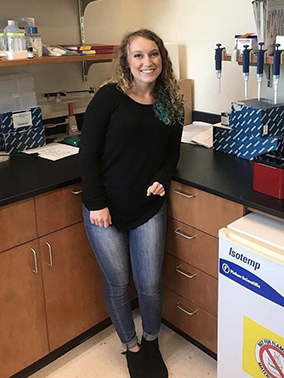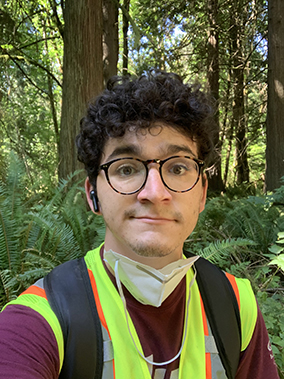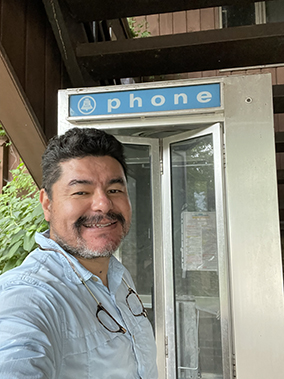
Graduate Students
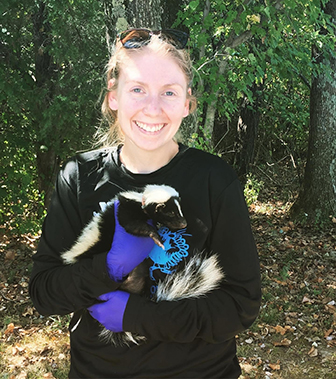
Kate Amspacher
Kate is a doctoral candidate coadvised between Dr. Clay Nielsen and Dr. Jiménez. Kate’s research broadly focuses on species’ responses to human modifications of the landscape, either from intentional management decisions or direct effects of urbanization and agriculture. Kate’s dissertation work is examining striped skunk ecology across an urban-rural gradient in southern Illinois. In her free time, Kate enjoys reading books, gardening, and hiking with her fiancé and dog. katelyn.amspacher@siu.edu. SUPERB NSF Biodiversity Fellow.
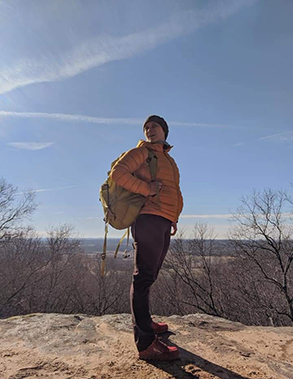
Guinivere Drabik
Hello, I am Guinevere Drabik. I started studying nematode parasites in my undergraduate at University Nebraska Lincoln. I am continuing my fascination with nematodes by pursuing my masters degree at SIU. I am currently studying New World Nippostrongyline worms. Outside of research you can cas I am either hiking in the woods or working on my next sewing project. guinevere.drabik@siu.edu. SUPERB NSF Biodiversity Fellow.
Ashley McDonald
Raccoons (Procyon lotor) are ubiquitous throughout the US and Illinois as they are extremely versatile animals. The density of raccoon populations in urban areas has significantly increased due to the abundance of anthropogenic resources such as food available at garbage cans and shelter. This close proximity to humans poses a potential health hazard as raccoons are known to carry various parasites that are transmissible to humans. My Ph.D. research will identify the prevalence of diseases and parasites in populations of northern Illinois with an emphasis on zoonotic species. I expect to establish the health risk that infectd raccoons pose to humans and assist wildlife managers to integrate the wellbeing of wildlife and people as . SUPERB ashley.g.mcdonald@siu.edu. SUPERB NSF Biodiversity Fellow.
Matthew Walker
Hello, my name is Matthew Walker. I am currently a master's student researching Gyrinicola batrachiensis, a tadpole pinworm, with focus on species diversity and variability throughout North America. I have a scientific interest in phylogenetic relationships and their implications on the evolution of the taxon. I also have a soft spot for island biogeography and how its concepts apply as a lens to the parasite world and parasite distributions. In my personal time I am a baker, runner, and crocheter. I have a diverse work background and am constantly fascinated by the world of parasites. SUPERB e-mail matthew.walker199@siu.edu. SUPERB NSF Biodiversity Fellow.
Undergraduate students
Andrew Capitosi
Andrew is characterizing the parasitic infecitons in small mammals from the Konza praire. He is planning to complete the characterization of nematode infections so these are incorpoated into the assessment of biodiversity of this Long Term Ecological Observatory.
Kayla Grey
Kayla works on the characterization of helminthic infections in striped skunks. She will study the effect of coinfections on the body condition of these mammals. SUPERB NSF Biodiversity Fellow.
Katie Karl
Katie is working on the determination of the nematode diversity of Neotropical amphibians and reptiles. She is the recipient of a REACH fellowship for the 2022-2023 academic year. Congratulations!
Nicole Olinger
Nicole works on the domestication of the life cycle of nematomorphs and on designing experiments to incorporate in teaching exercises. These experiments will help us teaching our students about the endeavour of scientific research, the intricacies of life cycles and the time and resource commitment to test hypothesis.
Former Students
Carly Haywood
Fined tuned trapping techniques for wild nine-banded armadillos. She characterized infections in the northern edge of their distribution (coadvised with Dr. Clay Nielsen). SUPERB
Victoria Phillips
Habitat of ticks in fragmented forests. Her results underscored the relevance of scientific collections in public health. Now she is a vector ecologist in California. SUPERB NSF Biodiversity Fellow.
Haitham Alnaqeb
Reconstruction of the phylogenetic relationships of the Heligmosomoidea, with emphasis on Neartcic species. Earned his Ph.D. degree in 2021. Currently in Quassim City, Saudi Arabia.
Chris Smaga
Chris characterized the infections induced by Ophidiomyces ophiodiicola in snakes of southern Illinois. He found it! He is pursuing a Ph. D. in the Odum School of Ecology at the University of Georgia.SUPERB NSF Biodiversity Fellow.
Sean Lyons
Sean was working on the unique and fantastic Aspidodera raillieti from the northern coast of South America. He is completing his graduate work at George Mason University. He was also part of the University Band in SIU.SUPERB NSF Biodiversity Fellow.
Elliott Zieman
Elliott did two projects in the lab. First, he characterized the infections and screened the genetic variation of Deladelus siricidicola in woodwasps (coadvised with Dr. John Reeve). Then he studied the infection dynamics of the etiological cause of bobcat fever in bobcats and domestic cats (coadvised with Dr. Clay Nielsen). Currently an Assistant Professor at Eastern Illinois University.
Shelby Adams
Shelby characterized the helminthic infections in bobcats and modeled their distribution. This was a first since she had to secure the specimens and georeferences to build these models. (Coadvised with Dr. Clay Nielsen). She is a Wildlife Biologist for the Michigan DNR. Her presence and expertise help reaching out to the general public in appearances in public television.
Phil Scheibel
Phil addressed the phylogenetic relationships of trychostrongyles of didelphic marsupials. He was the first one publishing sequences of these worms and use those to reconstruct their ancestral character states.
Hailey Penticoff
She identified nematodes from small mammals from the Konza prairie. She is completing her D.V.M. degree at Michigan State.
Brian Rowan
He idnetified a new species of Hymenolepis from wild mice in the Konza Prairie. He is now working on his D.V.M. in the University of Glasgow.
Cailey Vandermark
Cailey screened wildlife for the presence of Trypanosoma cruzi. She recorded this parasite for the first time in Illinois. She is now a D.V.M. up north.
Jessica Weirich
She identified and named trichostrongyles of neotropical rats. She is now as a practicing D.V.M. in the west.
Hayley Falat
She identified nematodes from rodents collected in the French Guiana. She is completing her D.V.M. degree at University of Missouri.
Megan Schwarzinger
She screened bocat tissues for the presence of pathogens.
Frank Soveg
He processed several specimens of Rhopalias, and studied genetic and morphometric variability. He earned his Ph.D. in immunology fromt he University of Washington.
Beth Byles
Beth characterized the helminth fauna of mouse opossums from French Guiana. She is a D.V.M.
The PI
F. Agustín Jiménez
I am fascinated by parasites. I find their movements mesmarizing, and when I see their structures, I see an aura of radiant beauty. Further, their transmission is a testimony of unrivaled resilience and the materialization of biological processeses. I attempt to elucidate historical relationships among nematodes and their hosts and explore temporary and historical shifts that have shaped our world. My research focuses on the historical relationships among nematodes and their mammalian hosts across the Neotropics. In particular, I am interested in reconstructing and documenting instances of host capture and host switching. By dissecting the intricate evolutionary histories of both mammals and parasites, I plan to reconstruct the processes that resulted in the diversification of the fauna of the New World. Further, the study of nematode parasitoses provides valuable insights into the transmission dynamicsof parasites among sympatric hosts.
